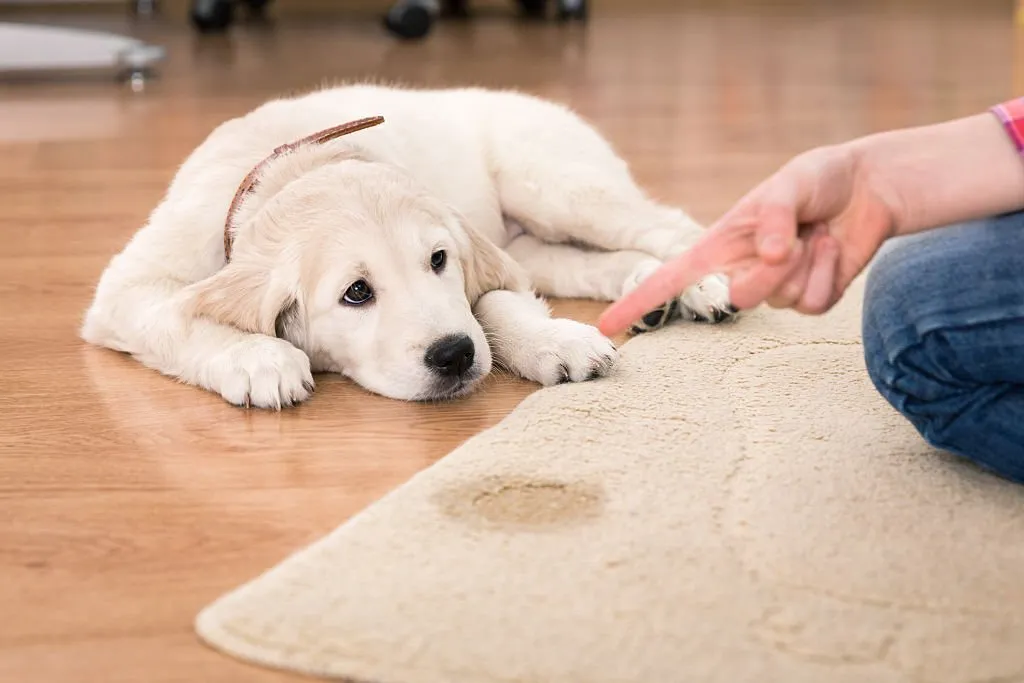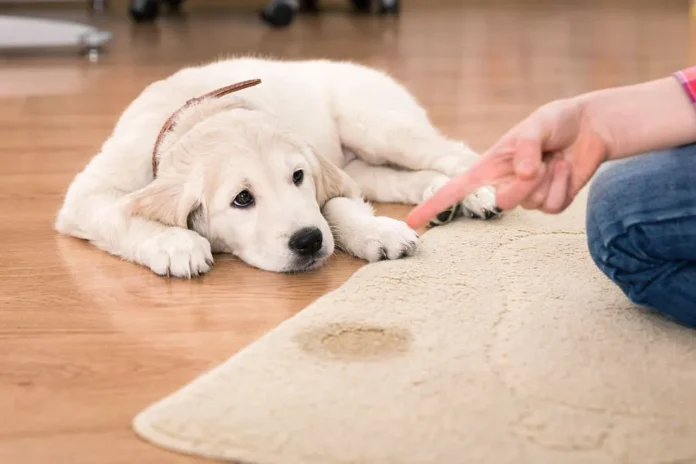Introduction
Submissive or excitement peeing is a common issue that many dog owners face. It is a behavior where a dog urinates when they are feeling nervous, anxious, or excited. This behavior can be frustrating for owners, but it is important to address it as it can be a sign of an underlying issue. In this article, we will discuss how to solve submissive or excitement peeing in dogs.

Understanding Submissive or Excitement Peeing in Dogs
Submissive or excitement peeing is a behavior where a dog urinates when they are feeling nervous, anxious, or excited. Submissive peeing is when a dog urinates to show submission or deference to a more dominant dog or person. Excitement peeing is when a dog urinates due to over-excitement or joy. Both behaviors are involuntary and can be difficult to control.
Dogs exhibit this behavior due to a lack of confidence or insecurity. They may feel overwhelmed or intimidated by a situation or person, causing them to urinate. It is important to understand that this behavior is not a sign of disobedience or defiance, but rather a natural response to a perceived threat or excitement.
Identifying the Triggers for Submissive or Excitement Peeing
Common triggers for submissive or excitement peeing include meeting new people or dogs, loud noises, sudden movements, and changes in routine. It is important to identify the triggers for your dog’s behavior so that you can work on desensitizing them to these situations.
To identify triggers, observe your dog’s behavior in different situations. Take note of when they exhibit submissive or excitement peeing and what is happening around them. This will help you pinpoint the triggers and work on addressing them.
Training Techniques to Prevent Submissive or Excitement Peeing
Positive reinforcement training is an effective way to prevent submissive or excitement peeing. This involves rewarding your dog for good behavior and ignoring bad behavior. Desensitization and counter-conditioning can also be used to help your dog become more comfortable in situations that trigger their behavior. Crate training can also be helpful in preventing submissive or excitement peeing.
Consistency in training is key to success. Make sure to use the same commands and techniques every time you train your dog. This will help them understand what is expected of them and make training more effective.
Positive Reinforcement Methods for Addressing Submissive or Excitement Peeing
Reward-based training is a positive reinforcement method that can be used to address submissive or excitement peeing. This involves rewarding your dog for good behavior with treats, praise, or toys. Clicker training is another effective method that uses a clicker to mark good behavior and reward your dog.
Treats and praise can also be used to reinforce good behavior. Make sure to use high-value treats that your dog loves to motivate them to behave well.
Consistency and Patience
Consistency and patience are key to success in addressing submissive or excitement peeing. It takes time and effort to change your dog’s behavior, so it is important to be patient and consistent in your training. It may take several weeks or even months to see progress, but with consistent training, you can help your dog overcome their behavior.
Avoiding Punishment: Why it Doesn’t Work for Submissive or Excitement Peeing
Punishment is not an effective way to address submissive or excitement peeing. It can actually make the behavior worse by increasing your dog’s anxiety and fear. Punishment does not address the root cause of the behavior, which is a lack of confidence or insecurity. Instead, focus on positive reinforcement training to help your dog feel more confident and secure.
Medical Causes of Submissive or Excitement Peeing: When to Consult a Vet
Submissive or excitement peeing can also be caused by medical conditions such as urinary tract infections or bladder problems. If your dog’s behavior does not improve with training or if they exhibit other symptoms such as frequent urination or blood in their urine, consult a vet to rule out any medical issues.
Environmental Factors that Contribute to Submissive or Excitement Peeing
Stressful environments or changes in routine can also contribute to submissive or excitement peeing. It is important to create a calm and stable environment for your dog to help them feel more secure. Stick to a routine as much as possible and avoid exposing your dog to stressful situations.
Tips for Managing Submissive or Excitement Peeing in Multi-Dog Households
If you have multiple dogs, it is important to manage their interactions to prevent submissive or excitement peeing. Make sure to supervise their interactions and separate them if necessary. During training, work with each dog separately to prevent competition or jealousy.
Celebrating Success: How to Reward Your Dog for Overcoming Submissive or Excitement Peeing
Celebrating success is important in reinforcing good behavior. Reward your dog with treats, praise, or toys when they exhibit good behavior. Make sure to maintain progress by continuing to train your dog and reinforcing good behavior.
Conclusion
Submissive or excitement peeing can be a frustrating behavior for dog owners, but it is important to address it to help your dog feel more confident and secure. Positive reinforcement training, consistency, and patience are key to success in addressing this behavior. Avoid punishment and consult a vet if necessary. With time and effort, you can help your dog overcome submissive or excitement peeing.


